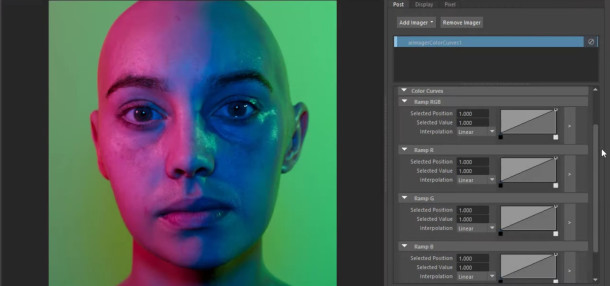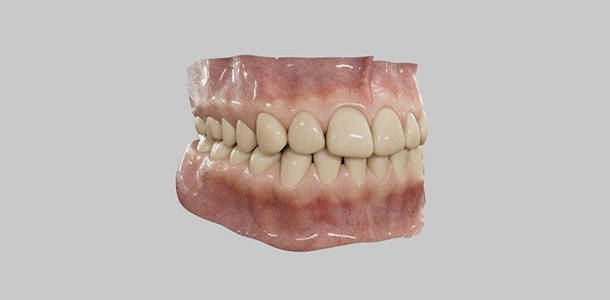Autodesk ships Arnold 7.0
Autodesk has released Arnold 7.0, the latest version of the production renderer, adding support for Open Image Denoise, extending the post-processing framework, and reducing memory usage in Arnold GPU.
The update also significantly extends USD workflows, adding support for deep AOVs and light linking; adds support for MaterialX 1.38; and makes ACEScg the default colour space for rendering.
Support for Open Image Denoise
The 7.0 update makes Arnold the latest renderer to integrate Open Image Denoise (OIDN), Intel’s AI-trained CPU-based render denoising framework.
It is provided in parallel with Arnold’s old CPU-based denoiser and Nvidia’s GPU-based OptiX denoiser.
Both the OIDN and OptiX denoisers can make use of Arnold 7.0’s new denoise_albedo_noisy AOV, which adds specular reflections and refactions to the albedo, potentially improving denoising quality.

Real-time colour correction: imager_color_curves makes it possible to adjust RGB components individually, with Arnold now previewing the output of an imager chain before the entire image has rendered.
Post-processing: new imager for colour correction, support for LUT-based looks
Arnold 7.0 also expands the framework of ‘imager’ post-processing nodes introduced in Arnold 6.1 last year.
As well as the OIDN denoiser, new imagers include imager_color_curves for colour correction, which provides separate control curves for individual RGB components and overall luminance, as shown above.
The existing tonemapping imager gets a new LUT mode for applying LUT-based looks to images.
LUTs can be applied in any format supported by the OpenColorIO 2 colour-management standard, which Arnold was one of the first VFX applications to support, including .cube, .look, .3dl and .clf files.
In addition, full-frame imagers are now updated during rendering, making it possible to preview the output of an imager chain before the entire frame has finished rendering.
Arnold GPU: matte support and reduced memory usage
Arnold’s GPU rendering framework, introduced in Arnold 5.3, continues to evolve, with Arnold GPU getting matte support for rendering holdout effects.
The matte shader, matte closure and matte shape flag are all now supported on the GPU.
In addition, GPU memory usage has been reduced when rendering polygonal geometry, with scenes with “heavy subdivisions” using “around 33% less GPU memory” than Arnold 6.2.1.
Arnold also now uses NanoVDB, Nvidia’s simplified GPU-based representation of OpenVDB volumes, with Arnold 7.0 providing a further 50-60% reduction in memory usage over Arnold 6.2.1.
The improvement makes GPU rendering more memory-efficient than CPU rendering for volumes. According to Autodesk, “GPU volumes now consume less VRAM than the equivalent CPU volumes consume RAM”.
USD: support for deep renders and light linking
Support for USD-based workflows, introduced in Arnold 6.0, has been expanded, with Arnold 7.0 adding support for deep rendering and light linking.
The update also adds support for UsdImaging adapters, making it possible to “transparently use Arnold-specific procedurals and shapes” in the USD Hydra viewer.
Other changes include support for path mapping when loading USD files, the option to calculate motion blur using velocity or acceleration primvars, and the option to write multiple frames to a single USD file.
MaterialX: a look-breaking update to MaterialX 1.38
Arnold’s support for MaterialX has been updated to MaterialX 1.38, the major update to the open standard for rich material and look development data rolled out earlier this year.
Due to the underlying changes to the format, looks and materials exported from Arnold are now expressed as combinations of Nodes and Inputs, rather than ShaderRefs and Params.
Although Arnold 7.0 can still render MaterialX documents exported from previous versions of the software, the changes are potentially look-breaking.
OpenColorIO: new OCIO 2 configuration rendering to ACEScg colour space by default
Arnold also now ships with a standard OpenColorIO (OCIO) 2 configuration compatible with the default OCIO 2 configuration introduced in Maya 2022.
By default, Arnold now uses an OCIO colour manager, which itself uses the OCIO configuration, rendering in ACEScg colour space.

Other changes: better subsurface scattering and more options for outputting AOVs
In addition, SSS Set Name, which enables subsurface scattering effects to spread between distinct objects in a scene, is now supported in random walk mode. as shown in the image above.
Visible lights are also now rendered as transparent, replacing the old, incorrect behaviour.
Users can also now render AOvs to multi-part EXR files, or to render a single AOV in multiple file formats.
Structural changes include support for multiple outputs for C++ and OSL shader nodes, and support for multiple parallel render sessions on the CPU.
The latter functionality is used in Arnold’s Maya integration plugin to render shader previews without interrupting the main render: about which, more later.
Performance improvements
The update also improves performance, particularly for progressive rendering.
The Triangle, Sinc, Blackman-Harris, Catmull-Rom and Mitnet filters all perform better in progressive mode, with Autodesk claiming an improvement of up to 48% in performance, and up to 20x in memory usage.
In addition, OSL texture lookups are faster, although Autodesk doesn’t quantify the speed boost.
Plugins for 3ds Max, Cinema 4D, Houdini, Katana and Maya updated
Arnold’s integration plugins for DCC applications have all been updated in parallel with the release, with MAXtoA 5.0 for 3ds Max, HtoA 6.0 for Houdini and KtoA 4.0 for Katana all upgrading to the Arnold 7.0 core.
In addition, MtoA 5.0 for Maya adds support for parallel preview renders on the CPU, enabling the software to update the Material Viewer in parallel with the primary render in the Render View or viewport.
Users can also perform file operations like Render to Texture in parallel with the primary render.
However, for impact on day-to-day workflow, the most significant update is probably C4DtoA 4.0 for Cinema 4D which also adds support for C4D’s node-based material system, introduced in 2018 in Cinema 4D R20.
System requirements and availability
Arnold 7.0 is available for Windows 10, RHEL/CentOS 7+ Linux and macOS 10.13-10.15. Integrations are available for 3ds Max, Cinema 4D, Houdini, Katana and Maya.
The software is rental-only, with single-user subscriptions starting at $45/month or $360/year. Multi-user subscriptions start at $630/year. The plugins are free.
Arnold GPU is supported on Windows and Linux only, and requires a compatible Nvidia GPU.
Read a full list of new features in Arnold 7.0 in the online documentation
